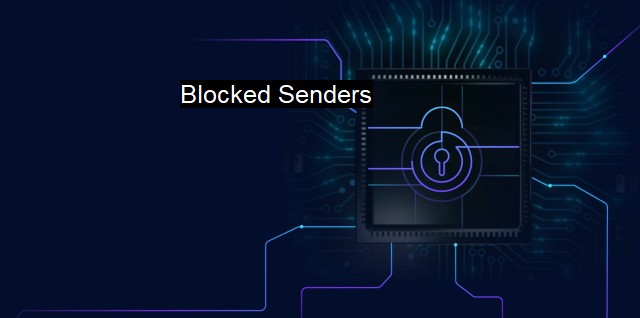What are Blocked Senders?
The Importance of Blocked Senders in Cybersecurity: Protecting Against Malicious Emails in Today's Online World
Blocked senders represent one part of a comprehensive online defense system that primarily functions against unwanted or potentially malicious emails. The term is extensively used in the field of email communications, where a user can basically 'block' certain email addresses of individuals or organizations from sending emails. This action generally deems the sender as unwanted or untrustworthy by positioning them on a blacklist, symbolizing they have been blocked. By pampering to the user's needs, this attribute helps in managing email communications more effectively, primarily in bolstering security procedures.An increasing reliance on digitization inevitably imports the augmented probability of cybersecurity threats, like spyware, adware, phishing, and computer viruses. One common method through which cybercriminals circulate such harmful components is through emails. Emails can be structured as spam or can even be specifically engineered to display a viable notion of authenticity. Operating on a intangible cloak of disguise, these emails, termed as phishing emails, are programmed to intrude and exploit user privacy once they successfully deceive the user into clicking an unfamiliar link they bear or downloading an obscured attachment.
Here arises the importance of the 'Blocked senders' functionality, as it stands to protect computer systems and their users' data by restricting potentially harmful sources. For instance, if a user consistently receives spam or questionable emails from certain addresses, they can position these senders into the 'Blocked senders' list to prevent future communication. This functions by either automatically deleting the emails or channeling them into the 'spam' or 'junk' folders directly.
Cloaked as a simple mechanism, the list employs a potent lot of advantages. The importance of managing the flow of email communication procures new heights as this utility helps in combating possible security breach, cushioning the effects of cyber threats. Further, pursuing the path of blocking certain senders actively discourages spammers and discourages them from attempting contact in the first place.
Expanding the scope, 'Blocked senders' constitute an essential feature in social media platforms and other applications where user interaction takes place. In these networking sites, the function prevents unwanted or perilous messages from infiltrating your account, keeping you safe from toxic or threatening interactions. it's important to highlight that merely blocking senders isn't always sufficient enough to battle the dynamic aura of advancing cyber threats. Parallelly, it also does not advocate the possibility of over-blocking that may result in prospective credible messages getting lost or shunned into junk folders, which fuels the need for cautious filtering.
Software providing virus and spam protection typically embrace the feature of blocked senders as part of their bulwark against cyber threats. Take, for instance, antivirus developers incorporate this in their products with design intricacies that support automatic updates of the blocked senders' list, based on advancing threats.
Blocked senders function as an inmate tool in the cyber defense portfolio. it’s not a stand-alone security measure and works optimally when employed in tandem with other protective armaments like firewalls, DNS Filters, Antivirus software, and secure networking protocols. Practicing safe computing, while also making full use of available security technologies such as the blocked senders feature in your email client can greatly reduce the risk and potential impact of online threats. It accentuates creating the first line of defense against the ever-growing tactics of spam, scams, and other forms of cyber attack.

Blocked Senders FAQs
What is a blocked sender in terms of cybersecurity and antivirus?
In cybersecurity and antivirus, a blocked sender refers to an email address or domain that has been identified as a potential threat to the user's device or network. It is flagged and prevented from reaching the user's inbox to prevent security risks such as malware infections or phishing attacks.How do I check if an email address or domain is on my blocked senders list?
The process of checking your blocked senders list may vary depending on the email service or antivirus software you use. However, in general, you can find it in your email settings or antivirus settings. Look for a section labeled "Blocked Senders" or "Blocked Addresses." If you are unable to locate it, consult the software's documentation or contact support for assistance.Can I unblock a sender if I accidentally blocked them?
Yes, if you accidentally blocked a legitimate sender, you can unblock them by accessing your blocked senders list and removing their email address or domain. This process is also done through your email or antivirus settings.Can blocked senders still send me emails?
No, once an email address or domain is added to your blocked senders list, all emails from that source will be automatically blocked and prevented from reaching your inbox. However, it is possible for spammers or cybercriminals to change their email address or use different domains to bypass your blocks, so it is important to remain vigilant and keep your antivirus software up to date.| | A | | | B | | | C | | | D | | | E | | | F | | | G | | | H | | | I | | | J | | | K | | | L | | | M | |
| | N | | | O | | | P | | | Q | | | R | | | S | | | T | | | U | | | V | | | W | | | X | | | Y | | | Z | |
| | 1 | | | 2 | | | 3 | | | 4 | | | 7 | | | 8 | | |||||||